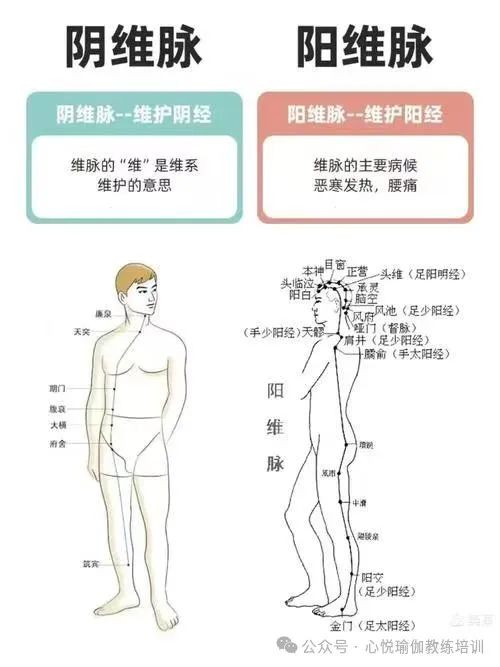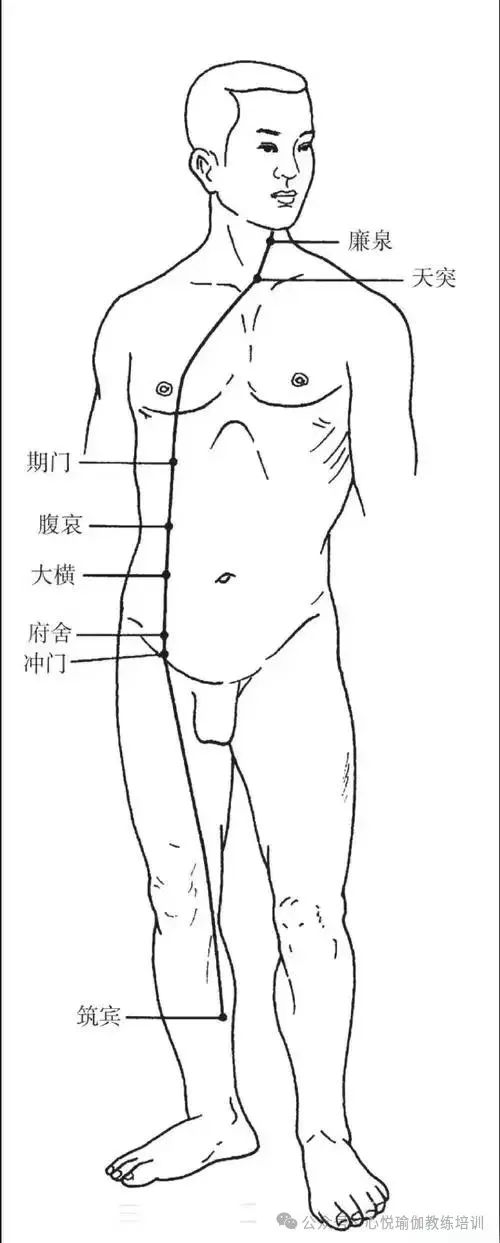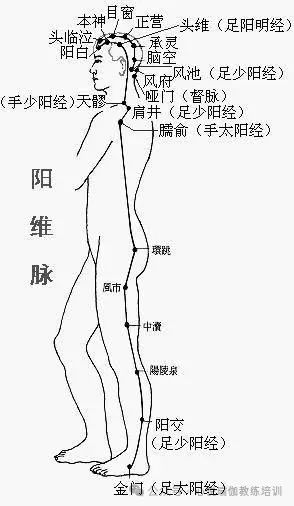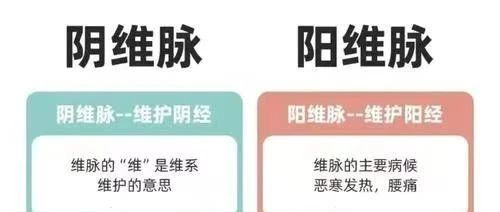In the system of Traditional Chinese Medicine (TCM), the Eight Extraordinary Meridians, particularly the Yin Wei Mai (Yin Linking Vessel) and Yang Wei Mai (Yang Linking Vessel), function as two invisible energy networks that maintain the temporal and spatial order of the human body. These two special meridians do not directly participate in the circulation of Qi and blood of the twelve regular meridians, but rather support the dynamic balance of life activities in the human body through a unique mechanical structure, akin to the stay cables in a building. The intersections of the Yin Wei and Yang Wei meridians conceal the codes of life, and their operational patterns resonate subtly with the theory of “correspondence between heaven and man” as described in the Huangdi Neijing, showcasing TCM’s profound understanding of the temporal and spatial structure of the human body.
As an important component of the Eight Extraordinary Meridians, the Yin Wei Mai plays a crucial role in TCM theory by maintaining and regulating the Yin and Yang meridians throughout the body. It has a unique pathway within the meridian system, linking the Yin meridians with the Yang meridians, thus forming a dynamic balance system of interior and exterior. They complement each other in pathology, diagnosis, and treatment, embodying the essential theory of “Yin and Yang harmony” in TCM.

1. Yin Wei Mai
The Yin Wei Mai originates at the Zhu Bin (Zhu Bin Point) on the inner side of the calf, climbing upwards like a vine and intersecting with several Yin meridians such as the Foot Taiyin Spleen Meridian and the Foot Shaoyin Kidney Meridian. The trajectory of this meridian aligns with the original pathway of human embryonic development, described in the Nanjing as “originating at the intersection of all Yin.” Its maintaining function is reflected not only at the anatomical level but also constructs a temporal and spatial continuum of the Yin meridian system at the energy level, ensuring the coordinated resonance of Qi and blood movement in the three Yin meridians. The Yin Wei Mai connects the three Yin meridians with the Ren Mai (Conception Vessel), forming a functional network centered on “interior, Yin, and inner,” which is crucial for regulating the Qi and blood of the internal organs and treating interior syndromes.
Classic Literature Reference
Nanjing, Chapter 28: The Yin Wei originates at the intersection of all Yin.
Zhenjiu Jiayi Jing: The Yin Wei meridian connects the body and governs the interior of the body.
Intersecting Meridians: Connects with several Yin meridians including the Foot Shaoyin Kidney Meridian, Foot Taiyin Spleen Meridian, Foot Jueyin Liver Meridian, and the Ren Mai.
1. Pathway of the Yin Wei Mai
Starting Point: Begins at the inner side of the calf (Zhu Bin Point, belonging to the Foot Shaoyin Kidney Meridian, located 5 cun above the Taixi Point, at the lower edge of the medial belly of the gastrocnemius muscle).
Lower Limb Section: Ascends along the inner side of the lower limb, passing through the inner thigh.
Runs parallel to the Foot Taiyin Spleen Meridian and Foot Jueyin Liver Meridian.
Abdominal and Chest Section: Ascends to the abdomen, intersecting at the Chongmen, Fushe, Daheng, and Fubai points of the Foot Taiyin Spleen Meridian.
Continues upwards to the hypochondriac region, intersecting at the Qimen point of the Foot Jueyin Liver Meridian (located in the 6th intercostal space, 4 cun lateral to the anterior midline).
Ascends along the side of the chest to the throat, intersecting at the Tian Tu point of the Ren Mai (located at the center of the suprasternal notch).
Finally, it intersects at the Lian Quan point of the Ren Mai (located above the Adam’s apple, at the midpoint of the upper border of the hyoid bone), completing its pathway.

2. Pathway Characteristics
Longitudinally connects the Yin meridians: Traverses the inner side of the lower limb, abdomen, chest, and throat, linking the three Yin meridians (Liver, Spleen, Kidney) with the Ren Mai.
Mainly treats internal conditions: Closely related to the functions of the internal organs (Heart, Liver, Spleen, Stomach), often manifesting pathologically as internal organ diseases (such as heart pain, stomach pain).
Intersects with the Ren Mai: Connects through the Lian Quan point, enhancing its governing role over the Yin meridians.
3. Key Acupoints (Intersecting Points)
Xi point: A location where Qi and blood gather deeply in the meridian, often used to treat acute pain.
During its pathway, the Yin Wei Mai intersects with several Yin meridians, and the following are key acupoints:
Zhu Bin (Foot Shaoyin Kidney Meridian): The Xi point of the Yin Wei Mai, regulates the lower jiao, calms the spirit, and treats Qi and blood stagnation, mania, hernia, and calf pain.
Fushe, Daheng, Fubai (Foot Taiyin Spleen Meridian): Regulates Qi and blood in the abdomen.
Qimen (Foot Jueyin Liver Meridian): Soothes the liver and regulates Qi.
Tian Tu, Lian Quan (Ren Mai): Opens the throat and regulates Qi mechanism.
4. Functions of the Yin Wei Mai
Maintains the Yin meridians: Connects all Yin meridians (such as Liver, Spleen, Kidney), coordinating the movement of Qi and blood in the Yin meridians.
Regulates internal conditions: Treats internal organ diseases (such as chest pain, stomach pain, heart pain, depression, and other “internal injury diseases”).
Balances Yin and Yang: Together with the Yang Wei Mai (which governs exterior conditions), maintains the balance of interior and exterior in the human body.
5. Associated Symptoms
Dysfunction of the Yin Wei Mai often leads to stagnation of Qi and blood in the Yin meridians, manifesting as:
Cardiac symptoms: Heart pain, chest tightness, palpitations (related to the Heart Meridian).
Digestive system symptoms: Stomach pain, abdominal distension, vomiting (related to the Spleen and Stomach Meridians).
Local symptoms: Rib pain (Liver Meridian), throat discomfort (Ren Mai).
Corresponding conditions: Coronary heart disease, chronic gastritis, anxiety disorders, menopausal syndrome, etc.
6. Health Maintenance for the Yin Wei Mai
Acupoints Zhu Bin, Qimen + Neiguan (Hand Jueyin Pericardium Meridian) alleviate angina and stomach pain.
Yin Wei Mai + Ren Mai: Regulates reproductive system diseases (such as irregular menstruation).
Yin Wei Mai + Liver Meridian: Relieves liver Qi stagnation and emotional issues.
2. Yang Wei Mai
The Yang Wei Mai begins at the Jinmen (Jinmen Point) of the Foot Taiyang Bladder Meridian, ascending along the Gallbladder Meridian to form a complex network with the Hand and Foot Yang meridians. The trajectory of this meridian closely aligns with the pathway of the body’s defensive Qi, as recorded in the Zhenjiu Jiayi Jing, stating it “connects all Yang,” maintaining the dynamic balance of the Yang meridian system like the orbits of planets in the solar system. The acupoints along its pathway, such as Fengchi and Yamen, serve as important gateways for energy exchange between the body and the external environment.
The Yang Wei Mai is complementary to the Yin Wei Mai, connecting all Yang meridians, with its primary function being to maintain the Qi and blood of the Yang meridians throughout the body and regulate the balance of the body’s exterior (exterior conditions). It plays a significant role in defending against external pathogens and coordinating limb activities.
Nanjing, Chapter 28: “The Yang Wei originates at the convergence of all Yang” (emphasizing its intersection with all Yang meridians).
The meaning of “all Yang”: “Originating at all Yang” does not refer to multiple starting points but emphasizes the extensive intersections of the Yang Wei Mai with the Hand and Foot Yang meridians (Taiyang, Shaoyang, Yangming), thus traversing all Yang meridians, hence the term “connecting all Yang.”
Zhenjiu Jiayi Jing: Clearly states the relationship of intersection between the Yang Wei Mai and the Foot Taiyang, Shaoyang, and Governing Meridians.
1. Pathway of the Yang Wei Mai
From the outer side of the lower limb → lateral trunk → shoulder and neck → head, generally following a horizontal pathway from bottom to top and from outside to inside.
Jinmen (outer side of the heel) → Yangjiao (outer side of the knee) → Nao Yu (shoulder back) → Fengchi (back of the neck) → Yamen (back of the head)
Starting Point: According to Nanjing, Chapter 28, the Yang Wei Mai begins at the outer side of the heel, at the depression behind the fifth metatarsal tuberosity (Jinmen Point, belonging to the Foot Taiyang Bladder Meridian).
From the Jinmen Point, it ascends along the outer side of the lower limb, passing through the Yangjiao point (of the Foot Shaoyang Gallbladder Meridian), over the hip, ribcage, and up to the shoulder and neck, intersecting with the Nao Yu point (of the Hand Taiyang Small Intestine Meridian) and the Tian Liao point (of the Hand Shaoyang Sanjiao Meridian), ascending to the back of the head and intersecting with the Governing Meridian at the Fengfu and Yamen points, forming a horizontal network of the Yang meridians.

2. Pathway Characteristics
Horizontal connection, maintaining all Yang
The Yang Wei Mai does not directly participate in the circulation of the twelve meridians but connects the Hand and Foot Yang meridians (Taiyang, Shaoyang, Yangming) with the Governing Meridian through a horizontal interspersing method, forming a “regulatory network for Yang meridian Qi and blood.”
Core Function: Coordinates the Qi and blood of the Yang meridians, primarily governing the body’s surface defense (Wei Qi) and resisting external pathogens.
Surface Pathway: The pathway is concentrated on the outer sides of the limbs, the lateral trunk, and the back of the head and neck, closely related to external pathogenic diseases (such as wind-cold, heat conditions).
Wei Qi Operation: Sufficient Qi and blood in the Yang Wei Mai can enhance the body’s external defense capabilities; conversely, deficiency may lead to symptoms such as chills, fever, and spontaneous sweating.
3. Intersecting Meridians and Key Acupoints
The Yang Wei Mai connects with the Foot Taiyang Bladder Meridian, Foot Shaoyang Gallbladder Meridian, Hand Taiyang Small Intestine Meridian, Hand Shaoyang Sanjiao Meridian, and Governing Meridian through intersecting acupoints, forming a “network of Yang meridians”:
Lower Limb Section:
Intersects with the Foot Taiyang Bladder Meridian (Jinmen Point, primarily regulates acute pain and external pathogenic diseases).
Intersects with the Foot Shaoyang Gallbladder Meridian (Yangjiao Point, the Xi point of the Yang Wei Mai, excels in treating acute Yang meridian conditions, such as acute migraines, high fever from external pathogens, and sudden pain on the outer limbs).
Trunk Section:
Ascends along the ribs, intersecting with the Foot Shaoyang Gallbladder Meridian (Dai Mai, Wushu points, etc.).
Shoulder and Neck Section:
Intersects with the Hand Taiyang Small Intestine Meridian (Nao Yu Point, alleviates shoulder and back pain).
Intersects with the Hand Shaoyang Sanjiao Meridian (Tian Liao Point).
Head Section:
Intersects with the Governing Meridian (Fengfu, Yamen points, disperses wind and resolves exterior conditions, treats headaches), ultimately integrating the Qi and blood of all Yang meridians.
The Xi point of the Yang Wei Mai is the Yangjiao Point (Foot Shaoyang Gallbladder Meridian).
4. Functions of the Yang Wei Mai
Governs exterior conditions, related to Wei Qi
Maintains all Yang meridians: Connects all Yang meridians (such as Gallbladder Meridian, Bladder Meridian, Sanjiao Meridian), coordinating the movement of Qi and blood in the Yang meridians, primarily governing the body’s surface and related to Wei Qi.
Defends against external pathogens: Governs the body’s surface defense function, resisting invasion by wind, cold, dampness, and heat.
Regulates exterior conditions: Treats external pathogenic diseases (such as fever, headache, limb numbness, joint pain, etc.).
Balances Yin and Yang: Works in conjunction with the Yin Wei Mai (which governs interior conditions) to maintain the internal and external balance of the human body.
5. Associated Symptoms
Typical symptoms: Chills, fever, headache, body aches, joint swelling, skin itching.
Corresponding conditions: Colds, migraines, rheumatoid arthritis, urticaria, etc.
6. Health Maintenance for the Yang Wei Mai
Acupoints Fengchi, Yangjiao + Wai Guan (Hand Shaoyang Sanjiao Meridian) regulate external headaches and fever.
The Jinmen point is used for acute low back pain or limb pain caused by external wind-cold.
Yang Wei Mai + Governing Meridian: Enhances external defense function, preventing colds.
Yang Wei Mai + Gallbladder Meridian: Relieves Shaoyang meridian Qi, treating migraines.
3. Comparison of Yang Wei Mai and Yin Wei Mai
1. Basic Functions
Yin Wei Mai: Maintains all Yin meridians (such as the three Yin of the foot and hand), governs the interior of the body, closely related to the functions of the internal organs, especially the heart, chest, and stomach.
Yang Wei Mai: Maintains all Yang meridians (such as the three Yang of the foot and hand), governs the body’s surface, associated with surface defense functions, such as resisting external pathogens and regulating body temperature.
2. Pathway
Yin Wei Mai: Begins at the inner side of the calf (Zhu Bin Point of the Foot Shaoyin Kidney Meridian), ascends along the inner side of the lower limb, passes through the abdomen (intersecting with the Spleen and Liver meridians), and reaches the throat to intersect with the Lian Quan point of the Ren Mai.
Yang Wei Mai: Begins at the outer side of the heel (Jinmen Point of the Foot Taiyang Bladder Meridian), ascends along the outer side of the lower limb, passes through the back of the trunk and shoulder (intersecting with the three Yang meridians), and reaches the side of the head to intersect with the Fengfu point of the Governing Meridian.
3. Intersecting Acupoints
The Yin Wei Mai intersects with the Ren Mai at the Lian Quan point (neck), reflecting its governing role over the Yin meridians.
The Yang Wei Mai intersects with the Governing Meridian at the Fengfu point (back of the head), reinforcing its coordinating function over the Yang meridians.
4. Pathological Manifestations
Dysfunction of the Yin Wei Mai: Often manifests as internal organ symptoms, such as heart pain, chest pain, and stomach pain (related to Yin meridians).
Dysfunction of the Yang Wei Mai: Commonly presents with surface symptoms, such as chills, fever, headache, and limb weakness (related to external pathogen invasion).
5. Daily Maintenance
The Eight Meridians’ intersecting points are key to regulating the Yin and Yang Wei Mai:
Neiguan (Hand Jueyin Pericardium Meridian) connects to the Yin Wei Mai, often used to alleviate heart and chest diseases.
Wai Guan (Hand Shaoyang Sanjiao Meridian) connects to the Yang Wei Mai, commonly used to treat external conditions and head and face disorders.
Regular stimulation of the intersecting points (such as Lian Quan and Fengfu) and acupoints along the pathways can balance Yin and Yang Qi and blood.
6. Coordinating Yin and Yang
Both maintain the balance of interior and exterior, Yin and Yang. Insufficient Yin Wei Mai may lead to Yin deficiency and internal heat, while dysfunction of the Yang Wei Mai may result in Yang deficiency and external cold.
The Ren and Du Meridians ~ Ren Mai
The Ren and Du Meridians ~ Du Mai: The “General Supervisor” of Yang Qi in the body – pathways, acupoints, and health maintenance
The Eight Extraordinary Meridians ~ Chong Mai: The hub of life energy
The Eight Extraordinary Meridians ~ Dai Mai: The “belt” of human health and hub of health maintenance
The twelve meridians’ circulation and health maintenance, the relationship and connection rules of the twelve meridians
The naming of the twelve meridians
Please open in the WeChat client

